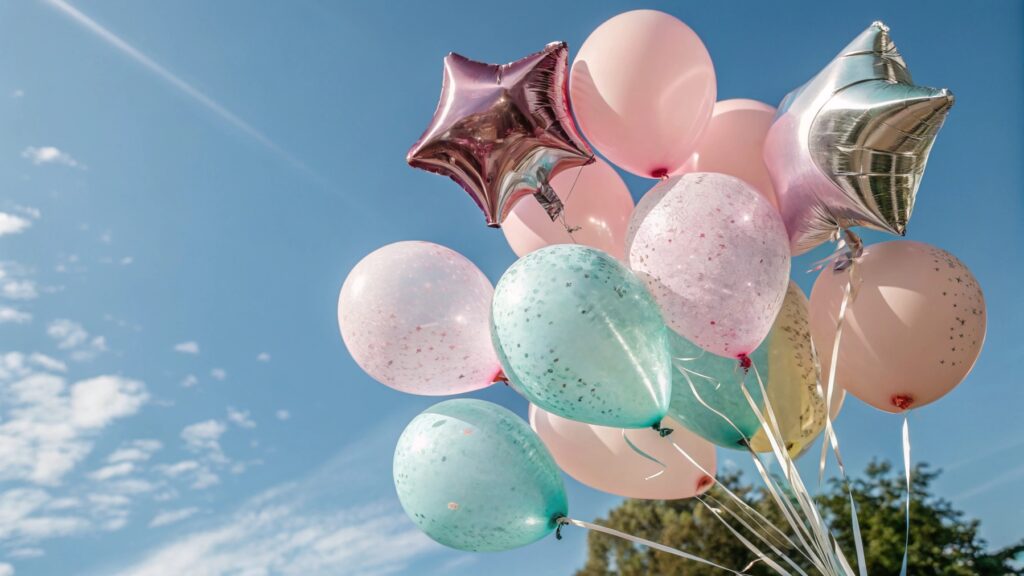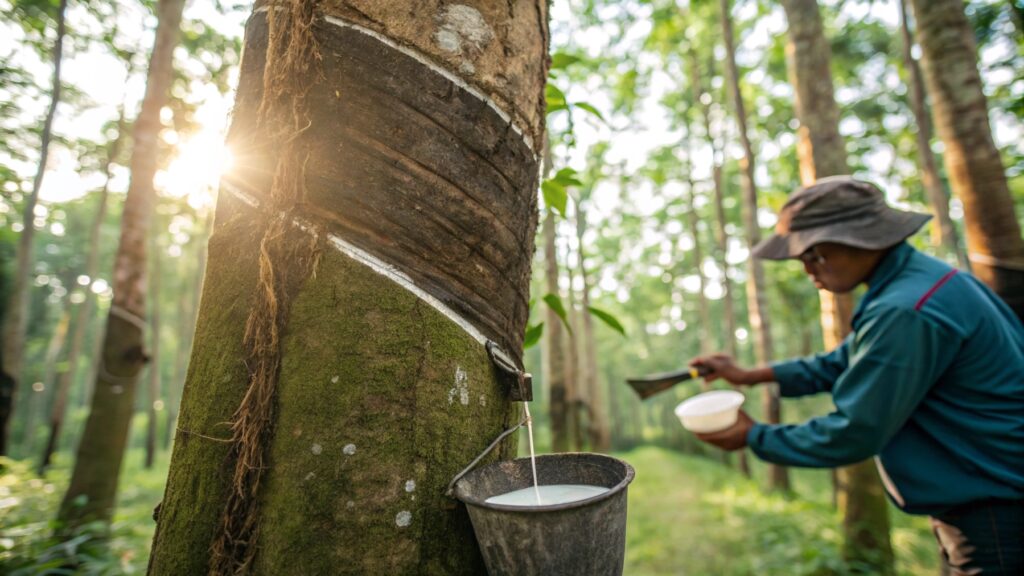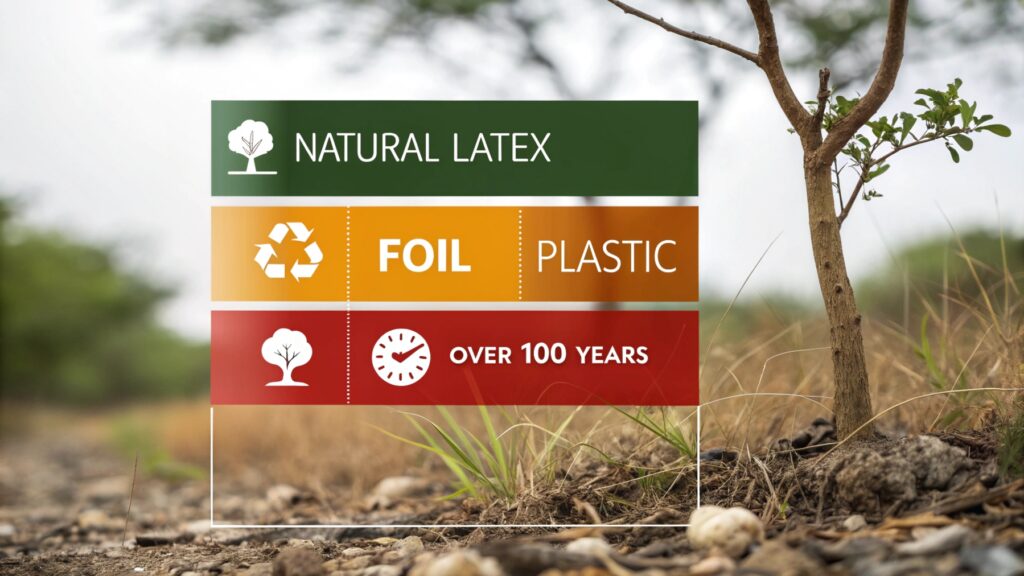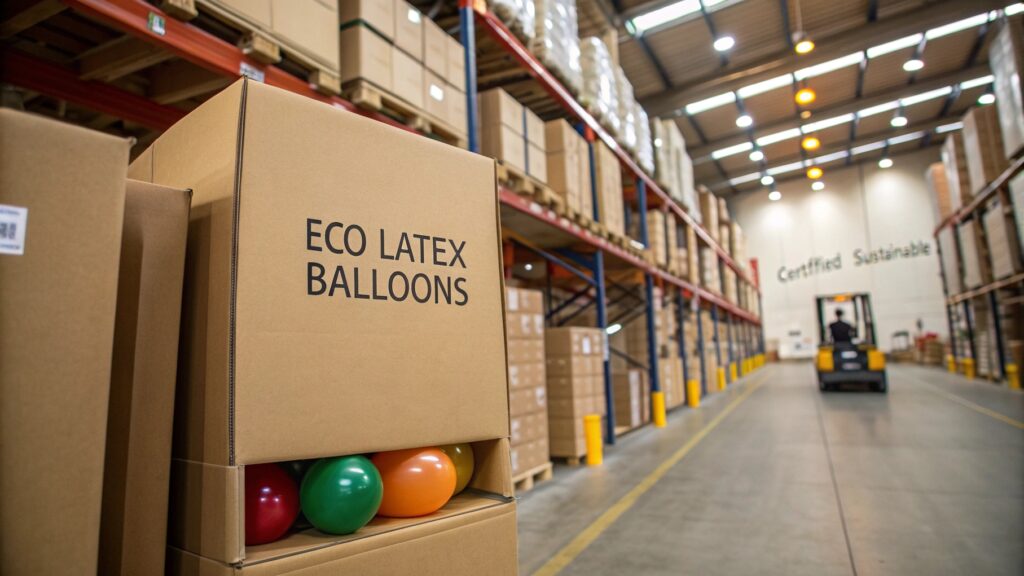How do eco-friendly balloons compare to traditional balloons?
Are you worried about the environmental impact of balloons? Do you want to make better choices for your events? I understand your concerns.
Eco-friendly balloons are often made from materials that break down faster than traditional ones. They aim to reduce the long-term impact on the environment compared to standard latex or foil balloons.

Choosing the right balloon can be confusing. There are many claims about what is eco-friendly. Let me share what I know about how these options stack up against each other. This will help you make informed decisions.
Are eco-friendly balloons1 truly biodegradable2?
Do you hear the term "biodegradable" and wonder if it's real? Is it just clever marketing? I've looked into this.
Some eco-friendly balloons, specifically those made from natural latex, are biodegradable. However, this process takes time and depends on the environment where they break down.

Let's look closer at what biodegradable means for balloons. It's not as simple as they disappear quickly. It depends heavily on the material and conditions. For example, a balloon in a landfill will take much longer to break down than one exposed to the elements. This is a key point that often gets missed. It's not instant or magic. It's a natural process.
Natural Latex vs. Other Materials
- Natural Latex Balloons3: These come from rubber trees. They are considered biodegradable. Microorganisms in the environment can break them down.
- Foil Balloons4: These are made of plastic and metal. They are not biodegradable. They last a very long time in landfills.
- Plastic Balloons: These are also not biodegradable. They contribute to plastic waste.
| Balloon Type | Material | Biodegradable? | Breakdown Time (Approx.) | Notes |
|---|---|---|---|---|
| Natural Latex | Natural Rubber | Yes | Weeks to Months | Requires specific environmental conditions |
| Foil (Mylar) | Plastic/Metal | No | Hundreds of Years | |
| Plastic (PVC) | Plastic | No | Hundreds of Years |
It's important to note that even biodegradable latex balloons can still harm wildlife if released. They can be mistaken for food. So, while the material is better, proper disposal is still needed. My experience tells me that focusing only on biodegradability isn't enough. We need to think about the full lifecycle of the product.
What materials are used in making eco-friendly balloons?
Have you ever wondered what makes a balloon "eco-friendly"? What materials are different from standard balloons? I've learned a lot about this.
Eco-friendly balloons primarily use natural latex, which is a renewable resource sourced from rubber trees. This is the main difference from balloons made from synthetic materials like plastic.

The choice of material is crucial for a balloon's environmental footprint. Natural latex is the gold standard for biodegradable balloons. It comes from a sustainable source. The process of tapping rubber trees is similar to tapping maple trees for syrup. It doesn't harm the tree. This makes it a renewable resource. This is a big plus compared to materials that come from fossil fuels. My company, AIHUA BALLOON, focuses on high-quality latex because of its better environmental profile and performance. We ensure our latex is sourced responsibly.
Different Materials and Their Impact
- Natural Latex5: Renewable, biodegradable. Production can have impacts like land use. Quality control is key to ensure purity.
- Synthetic Rubber6: Used in some non-latex balloons or blends. Less biodegradable than natural latex.
- Plastics (Nylon, Mylar): Used for foil balloons. Derived from fossil fuels, not biodegradable. Energy-intensive to produce.
- Additives (Colorants, Fillers): These are used in all balloon types. Eco-friendly options try to use less harmful dyes and chemicals.
| Material Type | Source | Renewable? | Biodegradable? | Primary Use in Balloons | Environmental Concern |
|---|---|---|---|---|---|
| Natural Latex | Rubber Trees | Yes | Yes | Latex Balloons | Land use, processing chemicals |
| Synthetic Rubber | Petrochemicals | No | No | Some Special Balloons | Fossil fuel source, non-biodegradable |
| Plastics (Mylar) | Petrochemicals | No | No | Foil Balloons | Fossil fuel source, long-term waste, microplastics |
Beyond the main material, the additives matter too. Dyes and processing chemicals can impact the environment. Responsible manufacturers use safer alternatives. For AIHUA BALLOON, strict quality control means not just performance but also checking the components for safety and environmental impact. This includes meeting standards like EUDR7, which ensures traceability back to the source to confirm sustainability claims. It's not enough to just say it's natural latex. We need to prove its origin and how it was produced. This level of detail matters.
How does the environmental impact differ between balloon types?
Are you wondering if the type of balloon really makes a difference to the planet? How does one balloon affect the environment compared to another? I've analyzed this from different angles.
The environmental impact varies greatly based on the balloon material, production process, and how it's disposed of. Natural latex balloons generally have a lower long-term impact than non-biodegradable foil or plastic balloons.

The environmental footprint of a product starts long before it's used and ends long after. For balloons, it involves raw material sourcing, manufacturing, transportation, use, and disposal. Natural latex balloons come from a renewable source. The trees absorb carbon dioxide. This is a positive. However, processing latex requires energy and chemicals. Foil balloons use fossil fuels for materials and production. They are very energy-intensive to make. Their main problem is disposal. They don't break down. They become long-lasting waste.
Lifecycle Impact Comparison
- Raw Material Sourcing: Natural latex is renewable. Foil/plastic uses non-renewable fossil fuels.
- Manufacturing: Both require energy. Foil production is often more energy-intensive due to metal coating. Quality control in latex manufacturing, like ours at AIHUA BALLOON, focuses on reducing waste and using safer processes.
- Transportation: Impact depends on distance and method. Lighter materials can reduce transport impact.
- Disposal: Natural latex biodegrades over time. Foil/plastic does not. Improper release of any balloon type is harmful to wildlife.
| Lifecycle Stage | Natural Latex Balloons | Foil/Plastic Balloons | Key Environmental Difference |
|---|---|---|---|
| Raw Material Sourcing | Renewable (rubber trees) | Non-renewable (fossil fuels) | Source renewability and carbon footprint |
| Manufacturing | Energy use, chemical use, waste production | Higher energy use, chemical use, waste production | Energy intensity and specific chemical use |
| Use | Single-use | Single-use (often) | No difference in use phase impact unless properly disposed |
| Disposal | Biodegrades over time (if in right conditions) | Does not biodegrade, long-term waste | Persistence in the environment |
Meeting standards like ISO9001 and Sedex, as we do at AIHUA BALLOON, means looking at these stages. ISO9001 ensures quality management, reducing waste and improving efficiency in manufacturing. Sedex addresses ethical and responsible sourcing, including environmental practices at raw material production sites. EUDR compliance further reinforces the traceability needed to prove the sustainable origin of latex. It's not just about the final product. It's about the whole chain. This comprehensive view shows why natural latex balloons, when properly managed, have a significantly lower environmental burden, especially concerning long-term waste.
Where can I buy sustainable balloon alternatives8 in bulk?
Are you a procurement manager looking for sustainable options in large quantities? Finding reliable suppliers for eco-friendly balloons can be a challenge. I can help you with this.
You can buy sustainable balloon alternatives, primarily high-quality natural latex balloons, in bulk directly from reputable manufacturers who prioritize environmental standards and traceability, like AIHUA BALLOON.

For bulk procurement, working directly with the source is often the best approach. It allows for better control over quality, sourcing, and compliance. As a procurement manager, you need confidence in the products you buy. This means asking questions about materials, production processes, certifications, and supply chain transparency. Companies like mine invest in these areas. We know that for large retailers and distributors, consistency and compliance are critical. We have built our operations to meet these needs. We focus on providing not just balloons, but also the assurance that they meet global standards, including environmental ones.
Finding the Right Bulk Supplier
- Look for Certifications: Check for certifications like ISO9001 (quality management), Sedex (ethical sourcing), and compliance with regulations like EUDR (for latex traceability).
- Inquire About Materials: Ask specifically about the type of latex (natural vs. synthetic) and other components.
- Request Quality Reports: A good supplier provides detailed quality control reports for their batches.
- Discuss Supply Chain Transparency9: Understand where the raw materials come from and how they are processed.
| Supplier Characteristic | Importance for Sustainable Bulk Buying | Why it Matters |
|---|---|---|
| Relevant Certifications10 | High | Ensures quality, ethical practices, and potentially traceability |
| Clear Material Information | High | Confirms use of preferred eco-friendly materials |
| Quality Reporting11 | High | Guarantees product consistency and adherence to standards |
| Supply Chain Transparency12 | High | Allows verification of sustainable and ethical sourcing |
| Experience in Bulk Orders | High | Indicates reliability for large-scale supply |
AIHUA BALLOON has 37 years of experience. My personal decade of experience in the industry, combined with an MBA, helps me understand the needs of large-scale procurement managers like Sarah Chen. We know you need more than just a good price. You need reliability, quality, and verifiable sustainability claims. Our commitment to standards, our traceable supply chain for latex under EUDR requirements, and our detailed quality control processes are designed to meet the demands of global retailers. We are set up to handle bulk orders efficiently and transparently, giving you peace of mind.
Conclusion
Choosing between eco-friendly and traditional balloons impacts the planet. Natural latex is a better, biodegradable option. Source from certified suppliers for sustainable bulk purchases.
-
Explore this link to understand the benefits and environmental impact of eco-friendly balloons compared to traditional options. ↩
-
This resource will clarify the meaning of biodegradable and its significance for eco-friendly balloon choices. ↩
-
Explore the advantages of Natural Latex Balloons, including their biodegradability and environmental impact, to make informed choices. ↩
-
Understanding why Foil Balloons are not biodegradable can help you make better decisions for the environment and reduce waste. ↩
-
Explore the advantages of natural latex balloons, including their biodegradability and renewable sourcing, to make informed choices for the environment. ↩
-
Understanding the environmental drawbacks of synthetic rubber can help you appreciate the benefits of choosing natural alternatives for balloons. ↩
-
Learn about EUDR's role in promoting sustainable practices and traceability in manufacturing, crucial for eco-friendly products. ↩
-
Discover reliable suppliers for eco-friendly balloon options that align with environmental standards and practices. ↩
-
Exploring supply chain transparency can reveal how materials are sourced and processed, ensuring ethical and sustainable practices. ↩
-
Understanding relevant certifications helps ensure quality and ethical practices in sourcing, crucial for sustainable procurement. ↩
-
Quality reports are essential for verifying product consistency and adherence to standards, making them vital for procurement decisions. ↩
-
Understanding the benefits of supply chain transparency can help businesses improve efficiency and build trust with consumers. ↩
